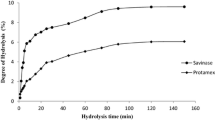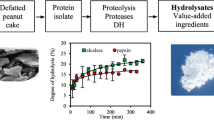Abstract
Purpose
The feather is a valuable protein resource. The feather is the major waste by-product resulting from the poultry processing plants. Therefore, increasing the values of poultry feather waste has a significant effect in the environment.
Methods
In this study, the physicochemical and functional properties as well as the antioxidant activities of the feather protein hydrolysates (FPHs) obtained by acid hydrolysis after 100 min (FPH100), 200 min (FPH200) and 300 min (FPH300) were investigated.
Results
The results showed that FPH100, FPH200 and FPH300 presented high protein content 74.04%, 71.05% and 73.94%, respectively. All FPHs had a good solubility and possessed some interfacial properties, governed by their concentrations. The antioxidant activities of the different FPHs were evaluated using various in vitro antioxidant assays such as 2,2-diphenyl-1-picrylhydrazyl (DPPH) radical-scavenging activity, total antioxidant capacity, reducing power and β-carotene bleaching. FPH100 generally showed a greater antioxidant activity across all the considered methods. The DPPH IC50 of FPH100 values were found to be 0.47 ± 0.011 mg/mL. Moreover, the FPH100 exhibited notable total antioxidant capacity and strong reducing power.
Conclusions
Our results suggested that FPHs could be a new potential source for preparing natural antioxidants applied in food, pharmaceutical and cosmetic preparations.





Similar content being viewed by others
References
Grazziotin, A., Pimentel, F.A., de Jong, E.V., Brandelli, A.: Nutritional improvement of feather protein by treatment with microbial keratinase. Anim. Feed Sci. Technol. 126, 135–144 (2006). https://doi.org/10.1016/j.anifeedsci.2005.06.002
Papadopoulos, M.C.: Processed chicken feathers as feedstuff for poultry and swine. A review. Agric. Wastes. 14, 275–290 (1985). https://doi.org/10.1016/S0141-4607(85)80009-3
Agrahari, S., Wadhwa, N., et al.: Degradation of chicken feather a poultry waste product by keratinolytic bacteria isolated from dumping site at Ghazipur poultry processing plant. Int J Poult Sci. 9, 482–489 (2010)
Paul, T., Halder, S.K., Das, A., Bera, S., Maity, C., Mandal, A., Das, P.S., Mohapatra, P.K.D., Pati, B.R., Mondal, K.C.: Exploitation of chicken feather waste as a plant growth promoting agent using keratinase producing novel isolate Paenibacillus woosongensis TKB2. Biocatal. Agric. Biotechnol. 2, 50–57 (2013). https://doi.org/10.1016/j.bcab.2012.10.001
Fakhfakh, N., Ktari, N., Haddar, A., Mnif, I.H., Dahmen, I., Nasri, M.: Total solubilisation of the chicken feathers by fermentation with a keratinolytic bacterium, Bacillus pumilus A1, and the production of protein hydrolysate with high antioxidative activity. Process Biochem. 46, 1731–1737 (2011). https://doi.org/10.1016/j.procbio.2011.05.023
Fontoura, R., Daroit, D.J., Correa, A.P.F., Meira, S.M.M., Mosquera, M., Brandelli, A.: Production of feather hydrolysates with antioxidant, angiotensin-I converting enzyme- and dipeptidyl peptidase-IV-inhibitory activities. New Biotechnol. 31, 506–513 (2014). https://doi.org/10.1016/j.nbt.2014.07.002
Grazziotin, A., Pimentel, F.A., Jong, E.V.D., Brandelli, A.: Poultry feather hydrolysate as a protein source for growing rats. Braz. J. Vet. Res. Anim. Sci. 45, 61–67 (2008)
Dalev, P.G.: Utilisation of waste feathers from poultry slaughter for production of a protein concentrate. Bioresour. Technol. 48, 265–267 (1994). https://doi.org/10.1016/0960-8524(94)90156-2
Coward-Kelly, G., Chang, V.S., Agbogbo, F.K., Holtzapple, M.T.: Lime treatment of keratinous materials for the generation of highly digestible animal feed: 1. Chicken feathers. Bioresour. Technol. 97, 1337–1343 (2006). https://doi.org/10.1016/j.biortech.2005.05.021
Laguerre, M., Lecomte, J., Villeneuve, P.: Evaluation of the ability of antioxidants to counteract lipid oxidation: existing methods, new trends and challenges. Prog. Lipid Res. 46, 244–282 (2007). https://doi.org/10.1016/j.plipres.2007.05.002
Phongthai, S., D’Amico, S., Schoenlechner, R., Homthawornchoo, W., Rawdkuen, S.: Fractionation and antioxidant properties of rice bran protein hydrolysates stimulated by in vitro gastrointestinal digestion. Food Chem. 240, 156–164 (2018). https://doi.org/10.1016/j.foodchem.2017.07.080
Shavandi, A., Hu, Z., Teh, S., Zhao, J., Carne, A., Bekhit, A., Bekhit, A.E.-D.A.: Antioxidant and functional properties of protein hydrolysates obtained from squid pen chitosan extraction effluent. Food Chem. 227, 194–201 (2017). https://doi.org/10.1016/j.foodchem.2017.01.099
Suwal, S., Ketnawa, S., Liceaga, A.M., Huang, J.-Y.: Electro-membrane fractionation of antioxidant peptides from protein hydrolysates of rainbow trout (Oncorhynchus mykiss) byproducts. Innov. Food Sci. Emerg. Technol. 45, 122–131 (2018). https://doi.org/10.1016/j.ifset.2017.08.016
Zhang, M., Mu, T.-H.: Identification and characterization of antioxidant peptides from sweet potato protein hydrolysates by Alcalase under high hydrostatic pressure. Innov. Food Sci. Emerg. Technol. 43, 92–101 (2017). https://doi.org/10.1016/j.ifset.2017.08.001
Kumar, D.M., Priya, P., Balasundari, S.N., Devi, G., Rebecca, A.I.N., Kalaichelvan, P.T.: Production and optimization of feather protein hydrolysate from Bacillus sp. MPTK6 and its antioxidant potential. Middle East J. Sci. Res. 11, 900–907 (2012)
Wan, M.-Y., Dong, G., Yang, B.-Q., Feng, H.: Identification and characterization of a novel antioxidant peptide from feather keratin hydrolysate. Biotechnol. Lett. 38, 643–649 (2016). https://doi.org/10.1007/s10529-015-2016-9
Ben Hamad Bouhamed, S., Kechaou, N.: Kinetic study of sulphuric acid hydrolysis of protein feathers. Bioprocess. Biosyst. Eng. 40, 715–721 (2017). https://doi.org/10.1007/s00449-017-1737-7
Gornall, A.G., Bardawill, C.J., David, M.M., et al.: Determination of serum proteins by means of the biuret reaction. J. Biol. Chem. 177, 751–766 (1949)
AOAC: Official Methods of Analysis, 17th edn. Association of Official Agricultural Chemists, Arlington (2000)
AOAC: Official Methods of Analysis, 16th edn. Association of Official Agricultural Chemists, Washington (1999)
AOAC: Official Methods of Analyses. Association of Official Agricultural Chemists, Washington D.C (1990)
Zou, Y., Wang, W., Li, Q., Chen, Y., Zheng, D., Zou, Y., Zhang, M., Zhao, T., Mao, G., Feng, W., Wu, X., Yang, L.: Physicochemical, functional properties and antioxidant activities of porcine cerebral hydrolysate peptides produced by ultrasound processing. Process Biochem. 51, 431–443 (2016). https://doi.org/10.1016/j.procbio.2015.12.011
Lin, M.J.Y., Humbert, E.S., Sosulski, F.W.: Certain functional properties of sunflower meal products. J. Food Sci. 39, 368–370 (1974). https://doi.org/10.1111/j.1365-2621.1974.tb02896.x
Pearce, K.N., Kinsella, J.E.: Emulsifying properties of proteins: evaluation of a turbidimetric technique. J. Agric. Food Chem. 26, 716–723 (1978). https://doi.org/10.1021/jf60217a041
Shahidi, F., Han, X.-Q., Synowiecki, J.: Production and characteristics of protein hydrolysates from capelin (Mallotus villosus). Food Chem. 53, 285–293 (1995). https://doi.org/10.1016/0308-8146(95)93934-J
Bersuder, P., Hole, M., Smith, G.: Antioxidants from a heated histidine-glucose model system. I: investigation of the antioxidant role of histidine and isolation of antioxidants by high-performance liquid chromatography. J. Am. Oil Chem. Soc. 75, 181–187 (1998). https://doi.org/10.1007/s11746-998-0030-y
Prieto, P., Pineda, M., Aguilar, M.: Spectrophotometric quantitation of antioxidant capacity through the formation of a phosphomolybdenum complex: specific application to the determination of vitamin E. Anal. Biochem. 269, 337–341 (1999). https://doi.org/10.1006/abio.1999.4019
Yıldırım, A., Mavi, A., Kara, A.A.: Determination of antioxidant and antimicrobial activities of Rumex crispus L. extracts. J. Agric. Food Chem. 49, 4083–4089 (2001). https://doi.org/10.1021/jf0103572
Koleva, I.I., van Beek, T.A., Linssen, J.P.H., de Groot, A., Evstatieva, L.N.: Screening of plant extracts for antioxidant activity: a comparative study on three testing methods. Phytochem. Anal. 13, 8–17 (2002). https://doi.org/10.1002/pca.611
Dathe, M., Schümann, M., Wieprecht, T., Winkler, A., Beyermann, M., Krause, E., Matsuzaki, K., Murase, O., Bienert, M.: Peptide helicity and membrane surface charge modulate the balance of electrostatic and hydrophobic interactions with lipid bilayers and biological membranes. Biochemistry. 35, 12612–12622 (1996). https://doi.org/10.1021/bi960835f
Kristinsson, H.G., Rasco, B.A.: Biochemical and functional properties of atlantic Salmon (Salmo salar) muscle proteins hydrolyzed with various alkaline proteases. J. Agric. Food Chem. 48, 657–666 (2000). https://doi.org/10.1021/jf990447v
Jemil, I., Jridi, M., Nasri, R., Ktari, N., Salem, R.B.S.B., Mehiri, R., Hajji, M., Nasri, M.: Functional, antioxidant and antibacterial properties of protein hydrolysates prepared from fish meat fermented by Bacillus subtilis A26. Process Biochem. 49, 963–972 (2014). https://doi.org/10.1016/j.procbio.2014.03.004
Zayas, J.F.: Solubility of proteins. In: Zayas, J.F. (ed.) Functionality of Proteins in Food, pp. 6–75. Springer, Berlin, (1997)
Gbogouri, G.a., Linder, M., Fanni, J., Parmentier, M.: Influence of hydrolysis degree on the functional properties of salmon byproducts hydrolysates. J. Food Sci. 69, C615–C622 (2004). https://doi.org/10.1111/j.1365-2621.2004.tb09909.x
Klompong, V., Benjakul, S., Kantachote, D., Shahidi, F.: Antioxidative activity and functional properties of protein hydrolysate of yellow stripe trevally (Selaroides leptolepis) as influenced by the degree of hydrolysis and enzyme type. Food Chem. 102, 1317–1327 (2007). https://doi.org/10.1016/j.foodchem.2006.07.016
Sila, A., Sayari, N., Balti, R., Martinez-Alvarez, O., Nedjar-Arroume, N., Moncef, N., Bougatef, A.: Biochemical and antioxidant properties of peptidic fraction of carotenoproteins generated from shrimp by-products by enzymatic hydrolysis. Food Chem. 148, 445–452 (2014). https://doi.org/10.1016/j.foodchem.2013.05.146
Marinova, K.G., Basheva, E.S., Nenova, B., Temelska, M., Mirarefi, A.Y., Campbell, B., Ivanov, I.B.: Physico-chemical factors controlling the foamability and foam stability of milk proteins: sodium caseinate and whey protein concentrates. Food Hydrocoll. 23, 1864–1876 (2009). https://doi.org/10.1016/j.foodhyd.2009.03.003
Hailing, P.J., Walstra, P.: Protein-stabilized foams and emulsions.Crit. Rev. Food Sci. Nutr. 15, 155–203 (1981). https://doi.org/10.1080/10408398109527315
Mutilangi, W.A.M, Panyam, D., Kilara, A.: Functional properties of hydrolysates from proteolysis of heat-denatured whey protein isolate. J. Food Sci. 61, 270–275 (1996). https://doi.org/10.1111/j.1365-2621.1996.tb14174.x
Thiansilakul, Y., Benjakul, S., Shahidi, F.: Compositions, functional properties and antioxidative activity of protein hydrolysates prepared from round scad (Decapterus maruadsi). Food Chem. 103, 1385–1394 (2007). https://doi.org/10.1016/j.foodchem.2006.10.055
Sánchez, C.C., Patino, J.M.R.: Interfacial, foaming and emulsifying characteristics of sodium caseinate as influenced by protein concentration in solution. Food Hydrocoll. 19, 407–416 (2005). https://doi.org/10.1016/j.foodhyd.2004.10.007
Lawal, O.S.: Functionality of African locust bean (Parkia biglobossa) protein isolate: effects of pH, ionic strength and various protein concentrations. Food Chem. 86, 345–355 (2004). https://doi.org/10.1016/j.foodchem.2003.09.036
García-Moreno, P.J., Batista, I., Pires, C., Bandarra, N.M., Espejo-Carpio, F.J., Guadix, A., Guadix, E.M.: Antioxidant activity of protein hydrolysates obtained from discarded Mediterranean fish species. Food Res. Int. 65, 469–476 (2014). https://doi.org/10.1016/j.foodres.2014.03.061
Shimada, K., Fujikawa, K., Yahara, K., Nakamura, T.: Antioxidative properties of xanthan on the autoxidation of soybean oil in cyclodextrin emulsion. J. Agric. Food Chem. 40, 945–948 (1992). https://doi.org/10.1021/jf00018a005
Wu, H.-C., Chen, H.-M., Shiau, C.-Y.: Free amino acids and peptides as related to antioxidant properties in protein hydrolysates of mackerel (Scomber austriasicus). Food Res. Int. 36, 949–957 (2003). https://doi.org/10.1016/S0963-9969(03)00104-2
Yıldırım, A., Mavi, A., Oktay, M., Kara, A.A., Algur, ÖF., Bilaloǧlu, V.: Comparison of antioxidant and antimicrobial activities of Tilia (Tilia Argentea Desf Ex DC), sage (Salvia Triloba L.), and black tea (Camellia sinensis) extracts. J. Agric. Food Chem. 48, 5030–5034 (2000). https://doi.org/10.1021/jf000590k
Sila, A., Nedjar-Arroume, N., Hedhili, K., Chataigné, G., Balti, R., Nasri, M., Dhulster, P., Bougatef, A.: Antibacterial peptides from barbel muscle protein hydrolysates: activity against some pathogenic bacteria. LWT-Food Sci. Technol. 55, 183–188 (2014). https://doi.org/10.1016/j.lwt.2013.07.021
Acknowledgements
This research was supported by the Tunisian Ministry of Higher Education, Scientific Research.
Author information
Authors and Affiliations
Corresponding author
Rights and permissions
About this article
Cite this article
Ben Hamad Bouhamed, S., Krichen, F. & Kechaou, N. Feather Protein Hydrolysates: A Study of Physicochemical, Functional Properties and Antioxidant Activity. Waste Biomass Valor 11, 51–62 (2020). https://doi.org/10.1007/s12649-018-0451-2
Received:
Accepted:
Published:
Issue Date:
DOI: https://doi.org/10.1007/s12649-018-0451-2




